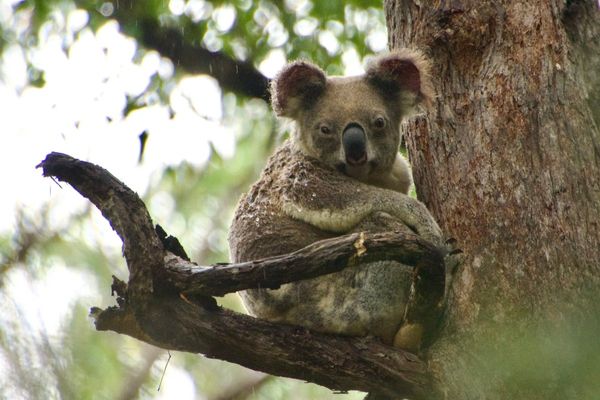
The coldest writers residency on the planet
I made my application for the Mike Riddell Writer in Residence in Ōtūrēhua, Central Otago, conditional on bringing the dog. I snuck him in. It was foreshadowed in a poem by Ōtūrēhua's poet in residence Brian Turner, titled “Van Morrison in Central Otago”:
You have to be here, you
have to feel the deep
slow surge of the hills,
the cloak of before, the wrench
of beyond.
And so Van Morrison rode with me in the back of a Cessna from Aotea Great Barrier Island, somewhere in the underbelly of an Airbus A320 to Dunedin, and along the Pigroot on a July evening, the river terraces and soft curves of the Kakanui hills pink and apricot with alpenglow. Then under a slivered, first quarter moon across a last rise into Ōtūrēhua, past Rose’s and Bridget’s and Jillian’s and Brian’s houses to Jenny’s, where I was gifted 40 days to write in the wilderness this winter by the Under Rough Ridge Writers' Retreat Trust.
I brought two coats for Van Morrison, a black singlet type fleece and a strap-over, grape-coloured outer jacket. The next morning, he was puzzled by the get-up and the hard pre-dawn frost on his paws when we went for a walk.
Sheep were flowing through tussock below the rail trail embarkment, felt more than seen, and I was unsure of the direction of I assumed was the Ida Burn which mumbled inside a line of willows. From a wooden bridge on schist blocks I saw the stream move with us, and we tagged along to a dam where a Jack Russell can walk on water.
The Rough Ridge and the Blackstone hills emerged around the frozen lake – tussocked, torred, scratched with matagouri – and the day flooded in from behind the Hawkdun Range. Back at the house there were notes on the coffee table, beautifully written, a 500-word sweep of the geography, history and culture of this place. Mike Riddell expected to hand them to me in person, a welcome to the residency he championed. But he didn’t wake from his sleep in March, and in April I accepted the offer of an inaugural residency in his name.
I arrived without a writing plan. I said in the residency application that I wanted to push deeper into the themes of Island Notes, my book about a 20-year love affair with an off-grid home and the wilds of Great Barrier Island, to reflect on “broader geographies”. I was up for a place as different as you can get in Aotearoa; coldest and hottest, a continental outpost in our dampish, wind-wracked archipelago. And to get to know and learn from a community of writers that have been taking over a sleepy one-time trucking town, population 31, eight of them published authors.
The trust sought writers keen to wrestle with the theme of the environment, and I quickly sensed discord between the writers and surrounding farmers, of being worn down by rights and wrongs and politicking, of wanting to move on from two years sheltering in place.
Van and I walked up Ōtūrēhua’s one road, past three houses to Gilchrist’s Store, opposite the Railway Hotel and next to the Community Hall, to get some eggs for breakfast. They were local, free range and mixed among groceries and museum pieces, and I was drawn into a strangely veiled conversation with the shopkeeper about Jacinda and how it’s OK to be kind, but … I untied the town’s best dressed dog from the bench outside and walked back wondering what the alternative to kindness might be?

In the other direction, past four houses and a yurt belonging to the poet Bridget Auchmuty, is Rosemary Riddell’s house, where a Nigel Brown painting of her husband hangs above a wood burner, surrounded by the faith-based, justice-seeking words he favoured. Among them The Insatiable Moon, the name of his 1997 novel about a rough sleeper and ‘second son of God’. Rosemary directed a feature film adapted from it, starring Rawiri Paratene, and last year published a memoir: To Be Fair: Confessions of a District Court Judge.
Turns out Mike chaired the Central Otago Environmental Society, set up in 2006 by Brian Turner and friends to advocate for the region’s natural character and landscapes in statutory planning processes. It has had its successes – notably opposition to proposed wind farms – but the issue of water allocation and the state of the Manuherekia River, which the Ida Burn I followed that morning flows into, has been vexing.
Rose told me there's a libel case against Mike and fellow society member Matt Sole after they criticised Otago Regional Councillors for failing to take decisions in the light of evidence of poor river health. Local farmers wrote letters to the editor Otago Daily Times and the mood was tense in the pub, where the writers meet each Friday before a shared meal.
The Manuherekia is the most overallocated river in the country, its minimum flow a quarter of what would otherwise reach its confluence with the Clutha Mata-Au at Alexandra. This compares to typical planning rules that aim to keep three quarters of the water in a river, to maintain Te Mana o Te Wai, now the guiding principle of our National Policy Statement on Freshwater.
Writer Jillian Sullivan has also borne criticism for sticking up for the environment. She keeps three never-to-be-eaten rescue cows (which Van and I feed hay bales to in the snow while she’s away) to reduce the risk of summer grass fires on her stony paddocks, and put in a trial hemp crop, to find alternative, more restorative uses for the land.
Her courage and community spirit are documented in her book A Way Home: Building a New Life and a Strawbale House in Central Otago, and Map for the Heart: Ida Valley Essays. The latter recounts a week-long walk the length of the Manuherekia to witness its withering state. She believes it’s chats around kitchen tables and working shoulder to shoulder on working bees (a roster for cleaning the public toilet, catering at the Brass Monkey Rally, chopping and stacking the community firewood supply) that can form the bonds needed to create understanding and find accommodations.
I took Van Morrison, who had already lost both his jackets chasing rabbits through broom, for a walk with ecologist Matt Sole on a section of the rail trail below his home at Chatto Creek.

He told me the popular Otago Central Rail Trail was not always so. Ex-National MP and Queenstown Mayor Warren Cooper declared it would grow weeds able to be seen from space and urged farmers to help themselves to the railway assets. A Department of Conservation manager at the time, Matt found silage feedlots on the tracks, gravel embarkments bulldozed to create a truck yard and bridge rails smashed to create tractor access to a pub.
A donation by a more enlightened farmer – Nora Calvert – gave DOC the confidence to press on with support from the Otago Central Rail Trail Charitable Trust, which has since raised funds and coordinated volunteer effort to upgrade the trail and preserve a hundred years of railway history.
Today 15,000 people bike the 152 km trail each year, usually over 3-5 days, staying and eating in pubs, accommodation and cafes. The average age is 57 and climbing with the popularity of e-bikes.
Van and I visited painter Grahame Sydney at Cambrians near St Bathans, where miners sluiced gold from gravels from the 1860s using high pressure hoses and race water diverted from the Manuherekia river. These first water rights became allocations for irrigation, supplemented by government dam building schemes in depression years and later transferred into water infrastructure companies in which farmers own shares.
Grahame is concerned the arid landscapes that he looks out over from his home and studio are disappearing, under wilding pines and the pivot irrigators that now snake across the terraces, where dairy cows feed on breaks of choumoellier, and ownership is passing from families to companies, incentivized by lending banks and successive governments’ calls for increased productivity.

NIWA’s atmospheric research station sits above the Manuherekia, near where the rail trail enters the Poolburn Gorge and passes through tunnels and over viaducts into the Ida Valley. The station was set up in the early 1960s and initially focussed on the stratosphere where nitrous oxide and chlorofluorocarbons were found to be destroying the ozone layer. But today research interest is shifting to the lower troposphere and greenhouse gases.
The station is recording an increase in CO2 in the atmosphere of 2 to 3 parts per million (ppm) each year. It is currently 410 ppm, 100 ppm up on baseline measurements taken 60 years ago. NIWA scientist Dave Pollard tells me that last year’s average air temperatures were higher in every month but one against the thirty-year average. Which is not good news for ice skaters or curlers. The last bonspiel on the Idaburn dam was in 2012 and regular curling competitions are looking increasingly unlikely.
Dave expects measurements will be made increasing from instruments on satellites, able to detect sources and sinks of CO2 or methane at individual forest, factory or farm level, so that polluters and those off-setting emissions can be incentivised and rewarded for working within agreed limits.
Halfway through my stay in the valley there was a meeting about the setting up of a new catchment group under glowing bar heaters in the Community Hall.
The group’s first stated objective is to retain access to irrigation water, but the farmer chairing the meeting says there’s an opportunity “to tick a few environmental boxes” and “get ahead of legislation that’s coming”. Van and I go and see Sam Stevens in the south end of the valley, where he grazes dairy cattle, runs a Poll Dorset sheep stud, and teaches practical farm skills two days a week to students from Maniototo Area School in Ranfurly. Without policies that enable intensive agriculture, he tells me, there’ll be no children at nearby Poolburn School where his wife teaches.
Back in the village Brian Turner’s house is across the road from mine. We watch All Blacks losses to the Irish, cycling highlights from Birmingham, and the first heavy snow of winter through thick curtains. The dog sits calmly among piles of books, memorabilia from a writing life, and bookshelves that hold three different collections that contain his poem “Van Morrison in Central Otago”.
Brian has spent a lifetime rallying against what’s commonly thought of as progress and development, querying those in power or held enthralled by doctrine. He says much has changed since he first fell for the landscapes of Central Otago, on family holidays, during stints with the rabbit board, while fishing its rivers and cycling under wide skies “and not much of it is for the better.” If he’d grown up in a farming family, he wonders if he might have seen things differently.
After six weeks in the valley in the warm and generous company of its writers, I have 45,000 words on my laptop. We gathered in Bridget’s yurt for a last meal together, hold hands as we have before potluck dinners every Friday, and I offered up a reading from my work in progress.
*
Day 41: Having a dog enables you to loiter without intent.
I sat yesterday for a couple of hours up on the rail trail, near the head of the valley, in the snow, and listened. Water, birds, sheep, cattle, distant vehicles.
I sat just beyond a sign marking the 45th Parallel on a section between gravel roads, near to a creek and looked out across whiteness. Plain, mountain, cloud.

A breeze that was present only in the slight movement of dry grass heads. A faint aroma of fallen apples, being eaten by the waxeyes in the snow.
When I thought I should leave, I replied to myself that I had nowhere else I needed to be, and would I ever again be in Central Otago like this?
I wondered how odd that we are always moving on as if there is somewhere new to be when in fact the place we are is just fine.
Well, more than that, it’s stunning.
It took five weeks from arrival for a decent dump of snow. There might be two or three like this a winter I’m told.
Then a cold to follow to hold everything in place and a calm to make it comfortable. Even a wisp of cloud and it would be too cold to sit for more than a few minutes. But today there’s none and there won’t be any for hours.
I think after a while – it’s easy to do this too – it would be nice to share this with someone else.
But there isn’t anyone I can magic up and place beside me and with whom I could share a look and acknowledge that this indeed is one of the best days of winter and we are in it together.
And so, I find myself lonely and catch myself and ask if this is another form of the pull that is always upon us.
An unexamined promise that there is some place and time ahead when communion will arrive.
And I wonder if it is a destination that only arrives at the end. So, we look for the hand that we might hold when it comes.
I stayed on the bench for a couple of hours watching the scene and my thoughts and feelings. Before calling Van Morrison from his rabbits.
I will look back one day and think, yes, I know Central Otago. Tim Higham was the inaugural winner of the Under Rough Ridge Writers Residency Award. It offered a 12-week residency in the village of Ōtūrēhua, a weekly stipend of $1000, and, crucially, free firewood.







